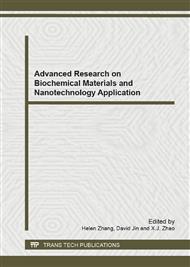p.60
p.64
p.68
p.72
p.76
p.83
p.87
p.92
p.96
Low Temperature CO Oxidation over Cobalt Catalysts Supported on Mesoporous CeO2
Abstract:
Mesoporous CeO2 was first synthesized by hydrothermal method, and then used to synthesize different content of (Co3O4)x/CeO2 (x was the molar ratio of Cu and Co) by deposition-precipitation method. The fresh and doped catalysts were characterized by X-ray diffraction (XRD), N2 adsorption and desorption, H2 temperature programmed reduction (H2-TPR) and O2 temperature programmed desorption (O2-TPD) to study the crystal structure, surface area, and the mechanism of CO oxidation. The results show that: In XRD pattems, the doped cobalt amounts of samples from x=20% to x=100% have Co3O4 crystal structure. The N2 adsorption and desorption indicated the samples were mesoporous structure. Compared with other samples, the better reducibility and activity oxygen species of (Co3O4)50%/CeO2 coincided with its better catalytic activity.
Info:
Periodical:
Pages:
76-82
Citation:
Online since:
January 2013
Authors:
Price:
Сopyright:
© 2013 Trans Tech Publications Ltd. All Rights Reserved
Share:
Citation:


